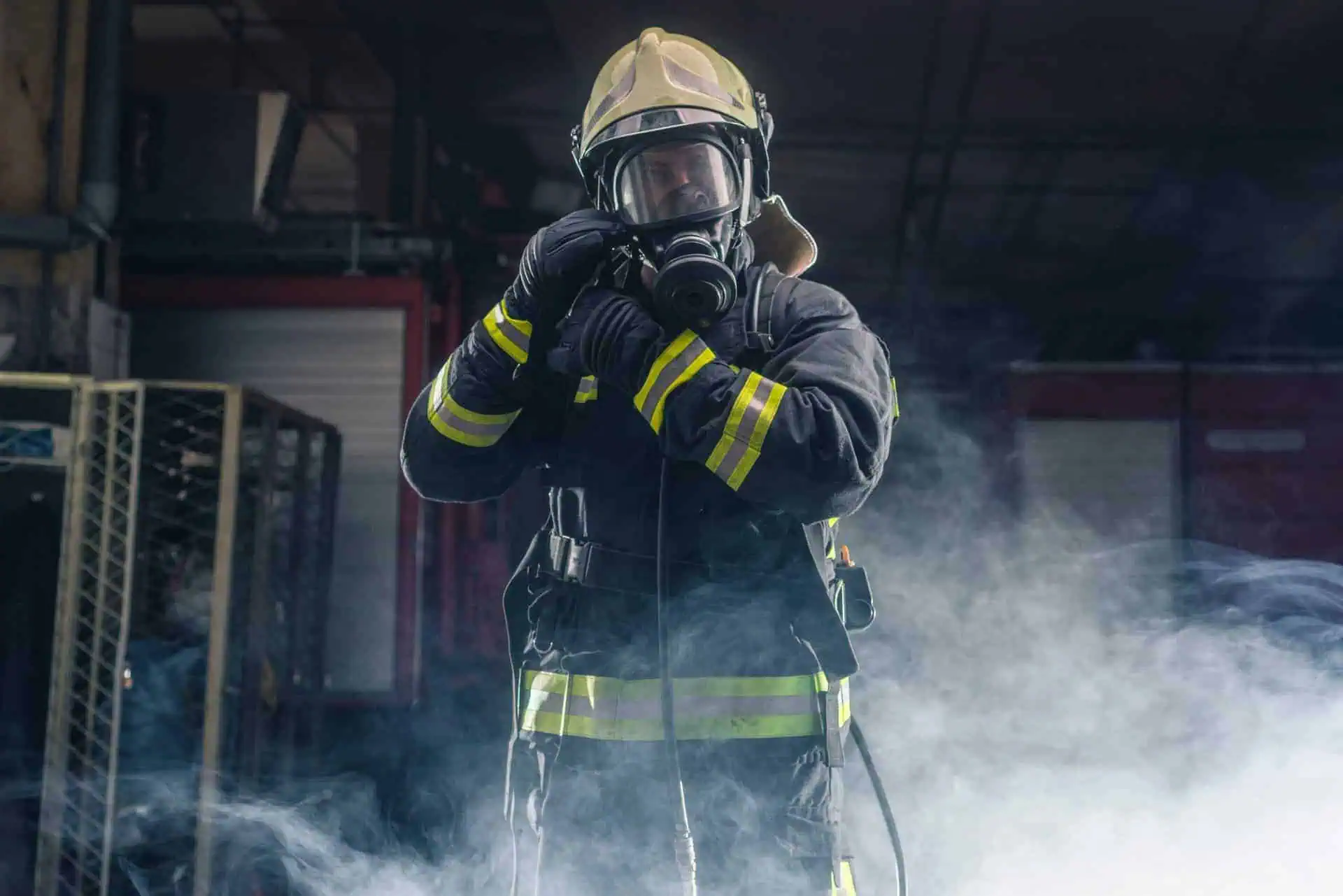PFAS in Firefighter Gear: IAFF Initiatives and Alternatives
- Last Updated: July 14th, 2025

Attorney Jessica Paluch-Hoerman, founder of TruLaw, has over 28 years of experience as a personal injury and mass tort attorney, and previously worked as an international tax attorney at Deloitte. Jessie collaborates with attorneys nationwide — enabling her to share reliable, up-to-date legal information with our readers.
Legally Reviewed
This article has been written and reviewed for legal accuracy and clarity by the team of writers and legal experts at TruLaw and is as accurate as possible. This content should not be taken as legal advice from an attorney. If you would like to learn more about our owner and experienced injury lawyer, Jessie Paluch, you can do so here.
Fact-Checked
TruLaw does everything possible to make sure the information in this article is up to date and accurate. If you need specific legal advice about your case, contact us by using the chat on the bottom of this page. This article should not be taken as advice from an attorney.
Key takeaways:
- PFAS in firefighter turnout gear poses a significant health risk to firefighters, with studies linking exposure to an increased risk of certain cancers, elevated cholesterol levels, and immune system dysfunction.
- Firefighters are particularly vulnerable to PFAS exposure due to the chemicals in their protective clothing, AFFF foam, and contaminated water sources encountered during firefighting activities.
- To minimize the risks associated with PFAS exposure, firefighters should be educated on proper handling and cleaning procedures for their gear while manufacturers and researchers work to develop PFAS-free alternatives that meet performance standards.
Overview of PFAS in Firefighter Gear
On this page, we’ll discuss the presence of PFAS in firefighter gear, Exposure Pathways and Risks in Firefighter Turnout Gear, best practices to mitigate the harm of PFAS-contaminated firefighting gear, and much more.
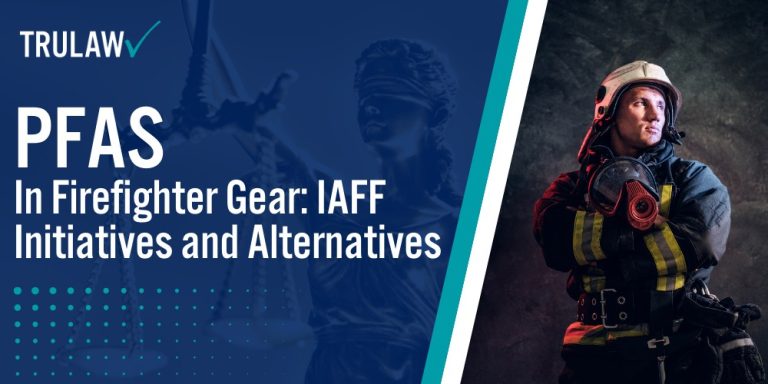
Intro to PFAS in Firefighter Gear
PFAS are a class of synthetic chemicals used in various products, including firefighter turnout gear, for their water-repellent and stain-resistant properties.
However, these chemicals, often called “forever chemicals,” have been linked to numerous health risks, making them a significant concern for the firefighting community.
PFAS in firefighting gear has gained attention for reasons that include, but are not limited to:
- Increased media coverage and public awareness of PFAS risks
- A growing body of research linking PFAS to adverse health effects
- Firefighter-specific concerns regarding occupational exposure to PFAS
As the issue of PFAS in firefighter’s protective clothing continues to gain traction, firefighters and their organizations, such as the National Fire Protection Association, must understand the risks and take action to protect their health and well-being.
Table of Contents
Health Risks of PFAS Exposure in Firefighter Gear
Exposure to PFAS has been associated with a range of adverse health effects, including certain cancers like testicular cancer, immune system dysfunction, and reproductive issues.
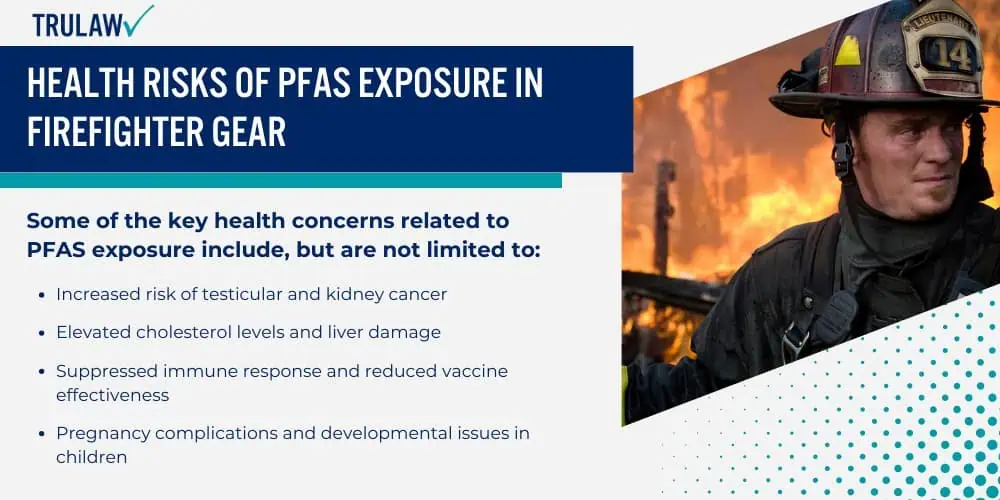
Firefighters are particularly vulnerable to these risks due to frequent contact with PFAS-containing gear and equipment.
Some of the key health concerns related to PFAS exposure include, but are not limited to:
- Increased risk of testicular and kidney cancer
- Elevated cholesterol levels and liver damage
- Suppressed immune response and reduced vaccine effectiveness
- Pregnancy complications and developmental issues in children
Given the severity of these potential health effects, firefighters must be aware of the risks associated with PFAS exposure and take steps to minimize their contact with these potentially cancer-causing chemicals.
PFAS 101: Understanding the Basics and Health Risks
Per- and polyfluoroalkyl substances (PFAS) are synthetic chemicals found in many consumer products due to their resistance to water, stains, and heat.
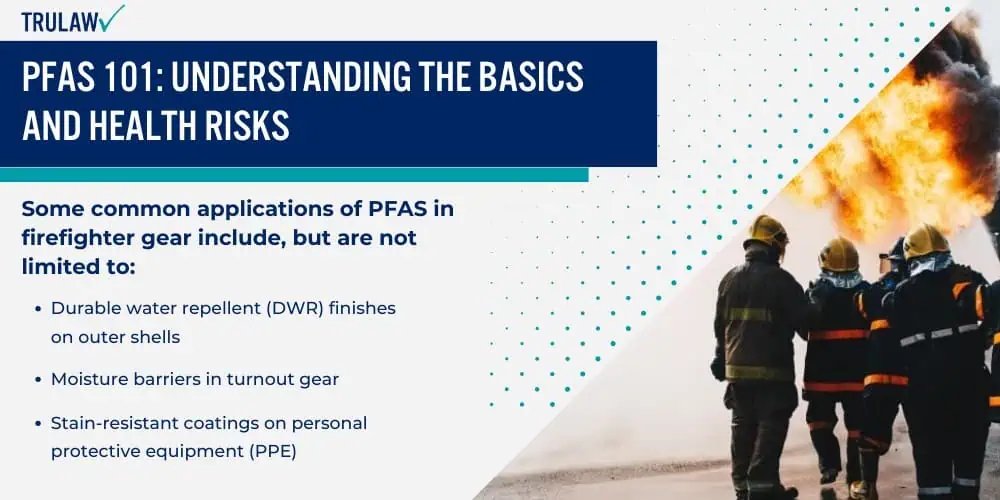
However, growing evidence suggests these chemicals may pose significant health risks, including cancer and hormone disruption.
What is PFAS? Uses and Applications in Firefighter Gear
PFAS are a class of over 12,000 compounds known for their water-repellent, stain-resistant, and heat-resistant properties.
These chemicals have been used in various products, including firefighter’s protective clothing, which is applied to the outer shell and moisture barrier to meet National Fire Protection Association standards.
Some common applications of PFAS in firefighter gear include, but are not limited to:
- Durable water repellent (DWR) finishes on outer shells
- Moisture barriers in turnout gear
- Stain-resistant coatings on personal protective equipment (PPE)
While PFAS has effectively protected against water, chemicals, and heat, their potential health risks have raised concerns about their continued use in firefighter turnout gear.
Health Risks of PFAS Exposure in Firefighter Gear
Exposure to PFAS has been linked to a range of adverse health effects, many of which are particularly concerning for firefighters who regularly come into contact with these chemicals through their gear and equipment.
Some of the most significant health risks associated with PFAS exposure include, but are not limited to:
- Increased risk of certain cancers, such as testicular and kidney cancer
- Elevated cholesterol levels and liver damage
- Immune system dysfunction and reduced antibody response to vaccines
- Pregnancy-induced hypertension and developmental issues in children
As evidence of the harmful effects of PFAS continues to mount, firefighters must be aware of these risks and take steps to minimize their exposure to these toxic chemicals.
Why PFAS in Firefighter Gear is Gaining More Attention
The issue of PFAS in firefighter turnout gear has gained significant attention in recent years, thanks in part to increased media coverage and growing public awareness of the risks associated with these chemicals.
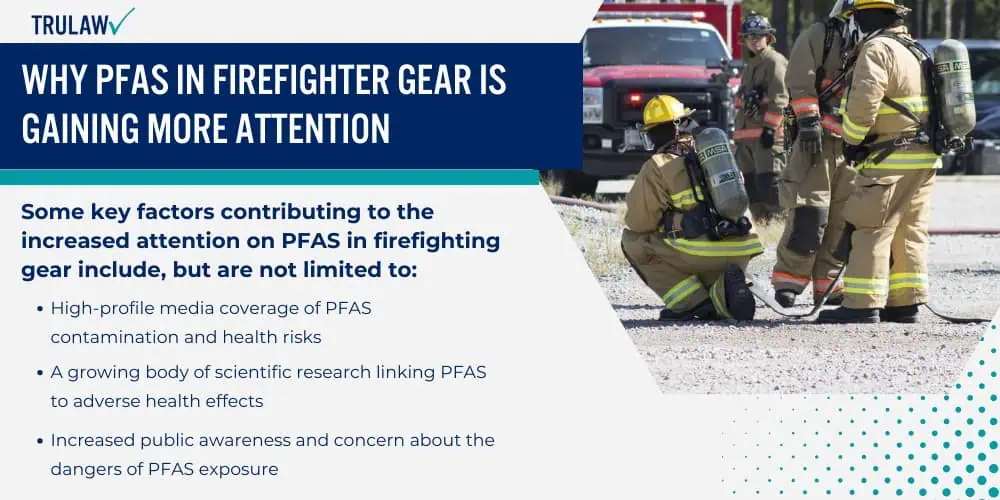
Media Coverage and Public Awareness of PFAS Risks
Movies like “Dark Waters” and media reports on the hidden dangers of PFAS have helped bring this issue to the forefront of public consciousness.
As more information about the potential health risks of PFAS exposure becomes available, firefighters and their organizations increasingly question the use of these chemicals in their gear and equipment.
Some key factors contributing to the increased attention on PFAS in firefighting gear include, but are not limited to:
- High-profile media coverage of PFAS contamination and health risks
- A growing body of scientific research linking PFAS to adverse health effects
- Increased public awareness and concern about the dangers of PFAS exposure
As the issue of PFAS in firefighter’s protective clothing continues to gain traction, the firefighter community must stay informed and advocate for safer alternatives to protect their health and well-being.
Firefighter-Specific Concerns with PFAS Exposure
Firefighters face unique risks concerning PFAS exposure, as they are regularly exposed to these chemicals through their turnout gear, AFFF foam, and contaminated water sources.
The nature of their work puts them at a higher risk of exposure compared to the general population.
Some firefighter-specific concerns with PFAS exposure include, but are not limited to:
- Frequent contact with PFAS-containing gear and equipment
- Exposure to PFAS through AFFF foam used in firefighting
- Potential contamination of water sources used by firefighters
- Inhalation, ingestion, and dermal absorption of PFAS during firefighting activities
Given the heightened risks faced by firefighters, the fire service must prioritize the development of PFAS-free turnout gear and implement best practices to minimize exposure.
Exposure Pathways and Risks in Firefighter Turnout Gear
Firefighters can be exposed to PFAS through multiple pathways, including their turnout gear, AFFF foam, and contaminated water sources.
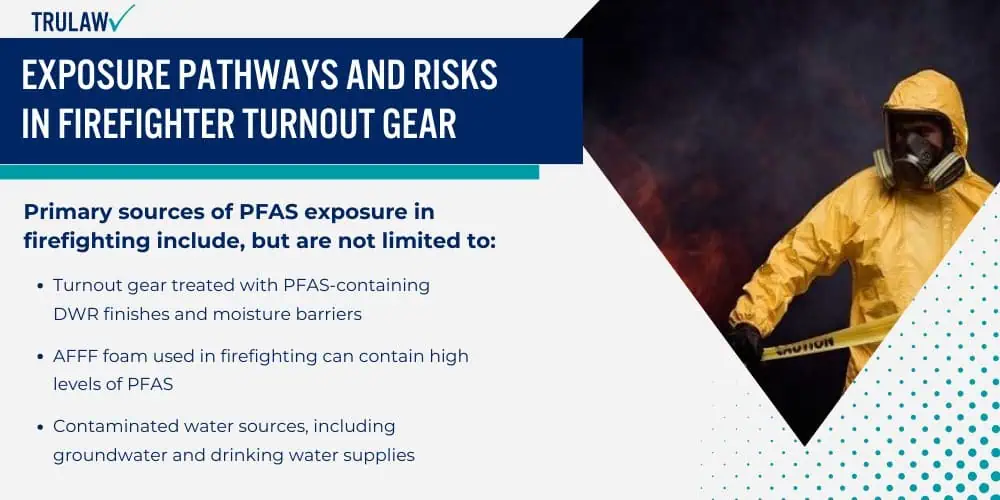
Understanding these exposure pathways is crucial for developing effective strategies to minimize risks.
Primary Sources of PFAS Exposure in Firefighting
PFAS exposure in firefighting can occur through several primary sources, each presenting unique challenges and risks for firefighters.
Primary sources of PFAS exposure in firefighting include, but are not limited to:
- Turnout gear treated with PFAS-containing DWR finishes and moisture barriers
- AFFF foam used in firefighting can contain high levels of PFAS
- Contaminated water sources, including groundwater and drinking water supplies
- Dust and debris in fire stations, which can have elevated levels of PFAS
By identifying and addressing these primary sources of exposure, firefighters can take steps to reduce their risk of PFAS-related health effects.
Key Studies and Findings on PFAS in Firefighter Gear
Several studies, including those conducted by the National Institute of Standards and Technology (NIST), have investigated the presence of PFAS in firefighter turnout gear and the potential risks associated with exposure to these chemicals.
Key studies and findings on PFAS in firefighter gear include, but are not limited to:
- Elevated levels of PFAS in the blood of firefighters compared to the general population
- Migration and transfer of PFAS from turnout gear to the skin of firefighters
- Higher PFAS concentrations in dust samples from fire stations compared to residential areas
- Potential for dermal absorption of PFAS from contaminated gear and equipment
These NIST studies highlight the need for further research and action to address the risks of PFAS exposure in the firefighter community.
Challenges in Eliminating PFAS from Firefighter Gear
Despite growing awareness of the risks associated with PFAS exposure, eliminating these chemicals from firefighter turnout gear presents several challenges that must be addressed to ensure the safety and well-being of firefighters.
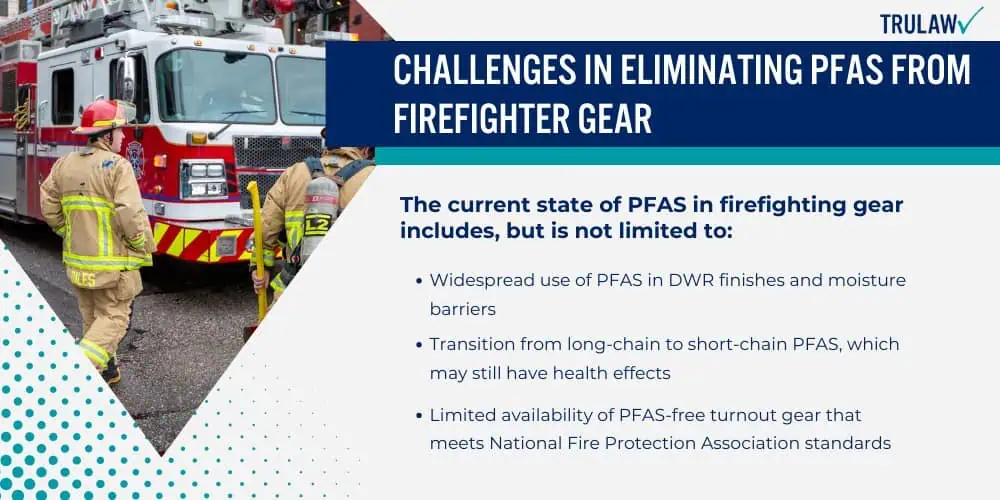
Current State of PFAS in Firefighter Turnout Gear
PFAS are currently used in most firefighter’s protective clothing, as they are essential for meeting National Fire Protection Association standards for water repellency and UV protection.
While some manufacturers have shifted from long-chain to short-chain PFAS, these alternatives may still pose health risks.
The current state of PFAS in firefighting gear includes, but is not limited to:
- Widespread use of PFAS in DWR finishes and moisture barriers
- Transition from long-chain to short-chain PFAS, which may still have health effects
- Limited availability of PFAS-free turnout gear that meets National Fire Protection Association standards
As the fire service works to address the risks of PFAS exposure, it is crucial to develop and adopt safer alternatives that provide the necessary protection without compromising firefighter exposure.
Barriers to Achieving PFAS-Free Firefighter Gear
Eliminating PFAS from firefighter’s protective clothing is a complex challenge that requires collaboration among manufacturers, researchers, and firefighting organizations.
Some of the main barriers to achieving PFAS-free turnout gear include, but are not limited to:
- Meeting National Fire Protection Association standards for water repellency and UV protection without PFAS
- Limited research and development of PFAS-free turnout gear
- Higher costs associated with developing and implementing new technologies
- Resistance to change within the fire service and gear manufacturers
Overcoming these barriers will require a concerted effort from all stakeholders to prioritize firefighters’ health and safety and invest in developing safer, PFAS-free turnout gear.
Mitigation Strategies and Best Practices for PFAS
While work continues to develop PFAS-free turnout gear, firefighters must adopt mitigation strategies and best practices to minimize exposure to these potentially cancer-causing chemicals.
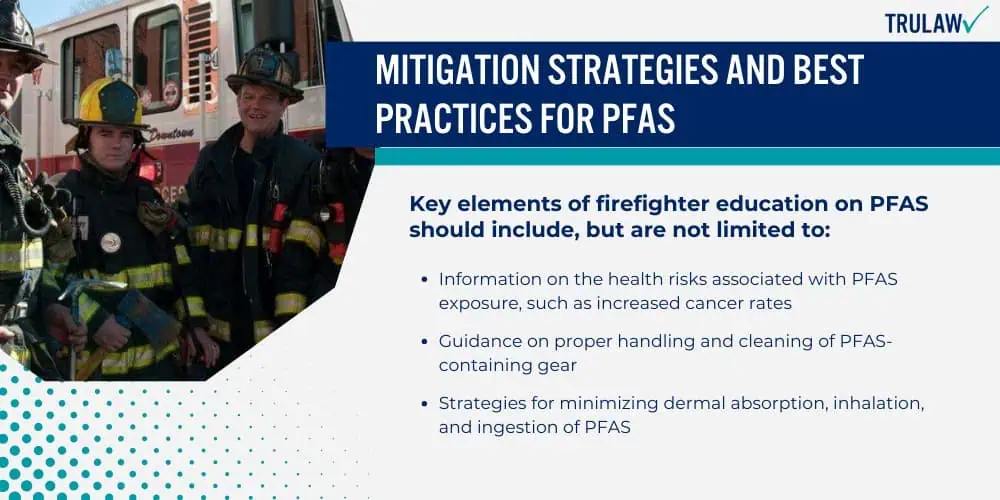
Educating Firefighters on PFAS Risks and Safety
One of the most important steps in addressing the risks of PFAS exposure is educating firefighters about the potential dangers and best practices for minimizing contact with these chemicals.
Key elements of firefighter education on PFAS should include, but are not limited to:
- Information on the health risks associated with PFAS exposure, such as increased cancer rates
- Guidance on proper handling and cleaning of PFAS-containing gear
- Strategies for minimizing dermal absorption, inhalation, and ingestion of PFAS
- Resources for staying informed about the latest research and developments in PFAS-free turnout gear
Fire departments can help reduce the risks of PFAS-related health effects by providing firefighters with the knowledge and tools they need to protect themselves.
Best Practices for Handling and Cleaning PFAS Gear
Proper handling and cleaning of PFAS-containing gear is crucial for minimizing exposure and reducing the risk of health effects.
Some best practices for handling and cleaning PFAS gear include, but are not limited to:
- Washing hands thoroughly before eating, drinking, or using the restroom
- Avoiding the use of compressed air to clean gear, which can aerosolize PFAS particles
- Using wet or damp cloths for cleaning gear and equipment
- Employing HEPA filters and air purifying systems in PPE storage areas
- Properly disposing of contaminated cleaning materials and wash water
By implementing these best practices, firefighters can significantly reduce their exposure to PFAS and minimize potential adverse health effects.
Future Directions and IAFF Initiatives on PFAS
The International Association of Fire Fighters (IAFF) is actively addressing the risks of PFAS exposure and advocating for safer alternatives to protect firefighters’ health and well-being.
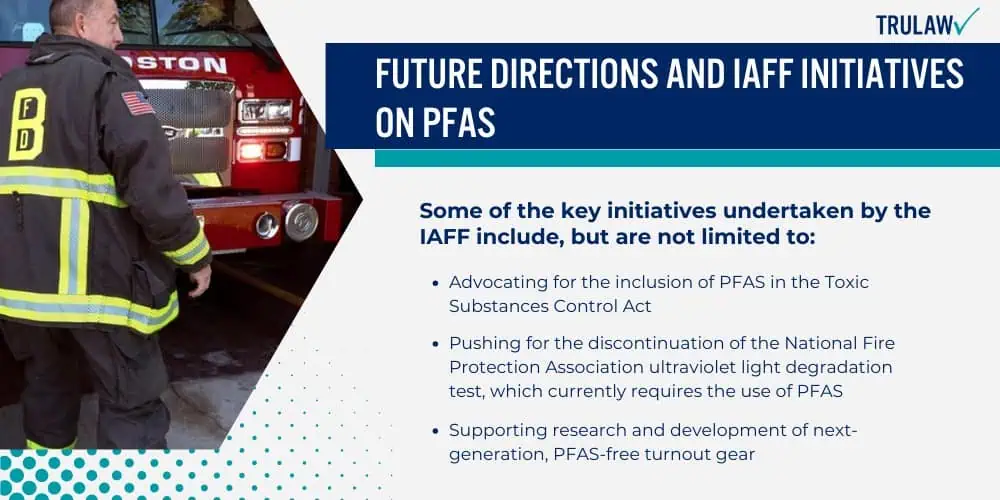
IAFF Advocacy and Research on PFAS-Free Gear
The IAFF is engaged in a range of advocacy and research efforts to eliminate PFAS from firefighter turnout gear and promote the development of safer alternatives.
Some of the key initiatives undertaken by the IAFF include, but are not limited to:
- Advocating for the inclusion of PFAS in the Toxic Substances Control Act
- Pushing for the discontinuation of the National Fire Protection Association ultraviolet light degradation test, which currently requires the use of PFAS
- Supporting research and development of next-generation, PFAS-free turnout gear
- Educating IAFF members about the risks of PFAS exposure and best practices for minimizing contact
Through these efforts, the IAFF is working to protect firefighters from the hidden dangers of PFAS and ensure a safer future for the fire service.
Moving Forward with PFAS Solutions in Firefighting
As the firefighter community continues to grapple with the risks of PFAS exposure, it is essential to maintain momentum in the search for safer alternatives and best practices.
Moving forward, key priorities for addressing PFAS in firefighting should include, but are not limited to:
- Continued research and development of PFAS-free turnout gear that meets performance standards
- Collaboration among manufacturers, researchers, and firefighting organizations to accelerate progress
- Ongoing education and training for firefighters on PFAS risks and best practices
- Advocacy for stronger regulations and policies to protect firefighter health
By working together and focusing on firefighter safety, the fire service can overcome the challenges posed by PFAS and ensure a healthier future for all.
Tru Law: Addressing PFAS in Firefighter Gear
The issue of PFAS in firefighter turnout gear represents a significant challenge for the firefighter community, but it can be overcome through education, collaboration, and a commitment to prioritizing firefighter health and safety.
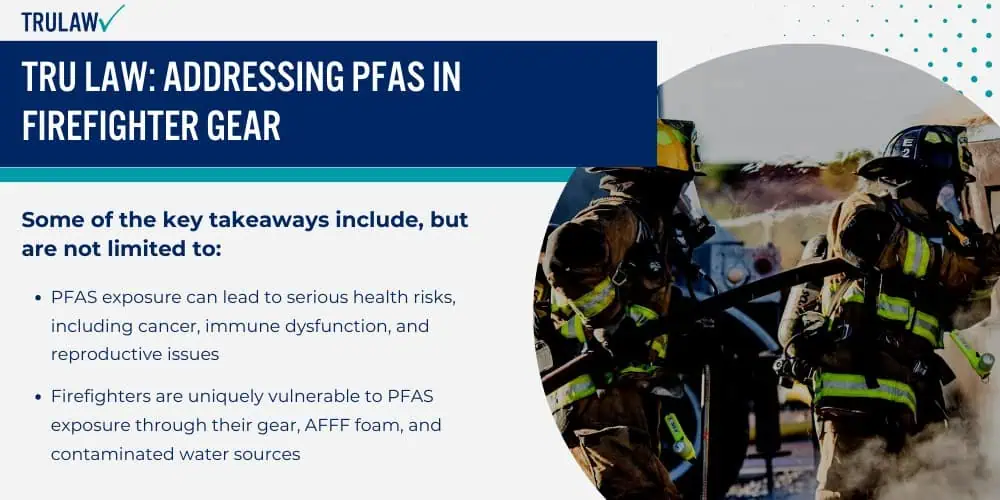
Key Takeaways on PFAS Risks and Safety Measures
Throughout this article, we have explored the hidden dangers of PFAS exposure in firefighting and discussed strategies for mitigating these risks.
Some of the key takeaways include, but are not limited to:
- PFAS exposure can lead to serious health risks, including cancer, immune dysfunction, and reproductive issues
- Firefighters are uniquely vulnerable to PFAS exposure through their gear, AFFF foam, and contaminated water sources
- Eliminating PFAS from firefighter’s protective clothing requires collaboration among manufacturers, researchers, and firefighting organizations
- Educating firefighters on PFAS risks and implementing best practices for handling and cleaning gear can help minimize exposure
By understanding these key points and taking action to address the risks of PFAS exposure, the fire service can work towards a safer, healthier future.
Final Thoughts on PFAS and Firefighter Protection
The issue of PFAS in firefighting gear is a complex and evolving challenge, but the firefighter community is well-equipped to tackle it.
By prioritizing firefighter health and safety, investing in research and development of safer alternatives, and maintaining open lines of communication and collaboration, we can work towards a future where firefighters are protected from the hidden dangers of PFAS exposure.
As we move forward, it is essential to remember that the well-being of our firefighters is paramount.
By taking action to address the risks of PFAS and advocating for safer, healthier working conditions, we can ensure that our brave first responders can continue their vital work without compromising their own health and safety.
Firefighter Turnout Gear Lawsuit Frequently Asked Questions
-
The protective gear firefighters wear is called turnout gear.
It includes a coat, pants, boots, gloves, and a helmet to protect firefighters from heat, flames, and other hazards.
-
Yes, studies have measured PFAS concentrations in firefighter turnout gear.
One study found that the moisture barrier layer in turnout gear contained high levels of PFAS compounds.
-
A firefighter’s protective clothing includes PFAS in the outer shell and moisture barrier layers.
These layers are treated with PFAS to provide water resistance and protection from chemicals and heat.
-
Yes, turnout gear typically contains more PFAS than other occupational clothing due to the specific performance requirements and the use of PFAS to meet those standards.
-
All the other hazards aside, the main hazard PFAS poses to firefighters is the potential for long-term health effects, such as an increased risk of certain cancers, due to repeated exposure to these chemicals through their turnout gear.

Managing Attorney & Owner
With over 25 years of legal experience, Jessica Paluch-Hoerman is an Illinois lawyer, a CPA, and a mother of three. She spent the first decade of her career working as an international tax attorney at Deloitte.
In 2009, Jessie co-founded her own law firm with her husband – which has scaled to over 30 employees since its conception.
In 2016, Jessie founded TruLaw, which allows her to collaborate with attorneys and legal experts across the United States on a daily basis. This hypervaluable network of experts is what enables her to share the most reliable, accurate, and up-to-date legal information with our readers!
Additional Firefighter Turnout Gear Lawsuit resources on our website:
Here, at TruLaw, we’re committed to helping victims get the justice they deserve.
Alongside our partner law firms, we have successfully collected over $3 Billion in verdicts and settlements on behalf of injured individuals.
Would you like our help?
At TruLaw, we fiercely combat corporations that endanger individuals’ well-being. If you’ve suffered injuries and believe these well-funded entities should be held accountable, we’re here for you.
With TruLaw, you gain access to successful and seasoned lawyers who maximize your chances of success. Our lawyers invest in you—they do not receive a dime until your lawsuit reaches a successful resolution!
AFFF Lawsuit claims are being filed against manufacturers of aqueous film-forming foam (AFFF), commonly used in firefighting.
Claims allege that companies such as 3M, DuPont, and Tyco Fire Products failed to adequately warn users about the potential dangers of AFFF exposure — including increased risks of various cancers and diseases.
Depo Provera Lawsuit claims are being filed by individuals who allege they developed meningioma (a type of brain tumor) after receiving Depo-Provera birth control injections.
A 2024 study found that women using Depo-Provera for at least 1 year are five times more likely to develop meningioma brain tumors compared to those not using the drug.
Suboxone Tooth Decay Lawsuit claims are being filed against Indivior, the manufacturer of Suboxone, a medication used to treat opioid addiction.
Claims allege that Indivior failed to adequately warn users about the potential dangers of severe tooth decay and dental injuries associated with Suboxone’s sublingual film version.
Social Media Harm Lawsuits are being filed against social media companies for allegedly causing mental health issues in children and teens.
Claims allege that companies like Meta, Google, ByteDance, and Snap designed addictive platforms that led to anxiety, depression, and other mental health issues without adequately warning users or parents.
Transvaginal Mesh Lawsuits are being filed against manufacturers of transvaginal mesh products used to treat pelvic organ prolapse (POP) and stress urinary incontinence (SUI).
Claims allege that companies like Ethicon, C.R. Bard, and Boston Scientific failed to adequately warn about potential dangers — including erosion, pain, and infection.
Bair Hugger Warming Blanket Lawsuits involve claims against 3M — alleging their surgical warming blankets caused severe infections and complications (particularly in hip and knee replacement surgeries).
Plaintiffs claim 3M failed to warn about potential risks — despite knowing about increased risk of deep joint infections since 2011.
Baby Formula NEC Lawsuit claims are being filed against manufacturers of cow’s milk-based baby formula products.
Claims allege that companies like Abbott Laboratories (Similac) and Mead Johnson & Company (Enfamil) failed to warn about the increased risk of necrotizing enterocolitis (NEC) in premature infants.
Here, at TruLaw, we’re committed to helping victims get the justice they deserve.
Alongside our partner law firms, we have successfully collected over $3 Billion in verdicts and settlements on behalf of injured individuals.
Would you like our help?
